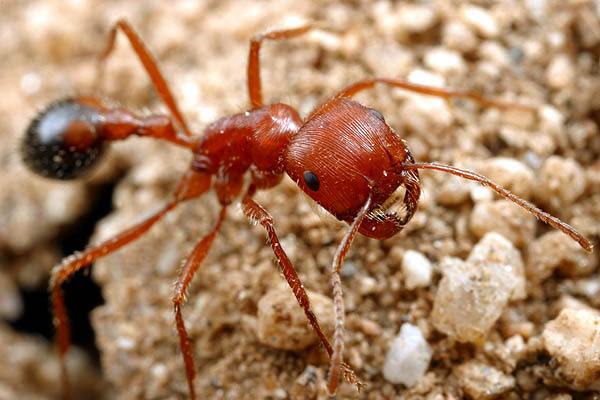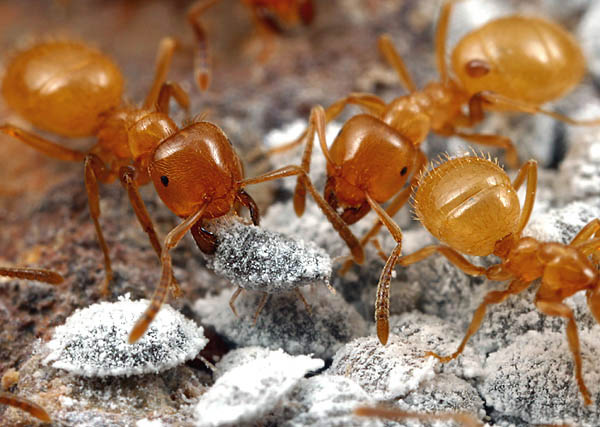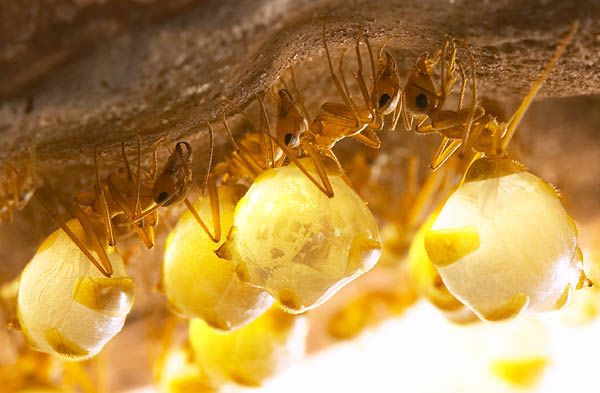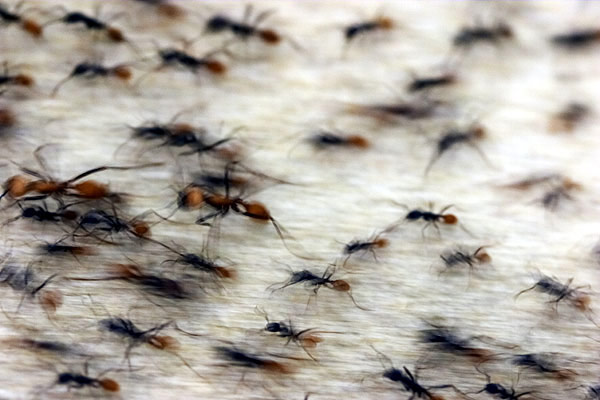Image Gallery: Ants of the World
Dolichoderus scabridus

Some plants supply nectar to ants in return for protection from herbivores. Here a Dolichoderus ant feeds from nectar. Dolichoderus are morphologically and ecologically diverse ants found worldwide. They are heavily sculptured and their bodies often ornamented with spines.
Oligomyrmex sp. – Small Ants

Major and minor workers of an Oligomyrmex species. Minor workers of Oligomyrmex are among the world's smallest ants. The ants pictured here, like many tropical rainforest insects, belong to a species that has not yet been described by scientists. Little is known about the biology of most species, but some are known to be thief ants, nesting alongside larger species of ants whose brood they prey upon.
Dinoponera australis - Large Ants

Dinoponera hunting ants are the largest ants in the Neotropics.
Myrmecia pyriformis - Brown Bull Ants

Myrmecia ants are a conspicuous element of the Australian insect fauna, and with the exception of a rare New Caledonian species they are found nowhere else. These large, elegant ants are regarded as having many primitive characteristics, including a relatively simple social structure, little morphological difference between queens and workers, and a basic foraging strategy where ants hunt for food individually using primarily visual cues.
Pogonomyrmex californicus- Pogonomyrmex Californicus Harvester Ants

A California harvester ant worker stands guard at the nest entrance. Pogonomyrmex are harvester ants found in arid habitats in North and South America. They are often large and conspicuous insects, and they play ecologically important roles as scavengers and seed dispersers. Pogonomyrmex are also known for their painful stings.
Odontomachus bauri - Trap-Jaw Ants

A trap-jaw ant stalks a young cricket. Odontomachus are large, conspicuous ponerine ants found in the tropics and subtropics worldwide. These predatory insects are noted for their unusual mandibles, which are held open at 180º and snap shut on a hair trigger.
Lasius (Acanthomyops) californicus - Citronella Ants

Citronella ants tending subterranean mealybugs. The ants derive much of their nutrition from mealybug secretions, and the mealybugs are protected and carried to new plants by their ant hosts. Also notice that the ant at the upper right has a mite riding on its abdomen. Lasius are commonly encountered ants in a wide variety of habitats in the North Temperate Zone in both the old and the new world.
Get the world’s most fascinating discoveries delivered straight to your inbox.
Myrmecocystus mexicanus - Mexican Honeypot Ants

Honeypot ants have an unusual food storage system. Some members of each colony act as living receptacles known as "repletes", these ants become engorged with food and hang from the ceilings of chambers deep underground. Myrmecocystus are soil-nesting ants endemic to the arid regions of western North America.
Amblyopone oregonensis - Dracula Ants

Amblyopone is an ancient group of predaceous ants found worldwide. These subterranean ants have elongate mandibles and a characteristic broad posterior attachment of the petiole. Amblyopone ants are specialist predators of geophilomorph centipedes. Here a worker ant carries a centipede it has paralyzed back to her nest.
Neivamyrmex californicus - Army Ants

Army ants on the march. This species, Neivamyrmex californicus, is endemic to California and Baja California. Neivamyrmex are the most diverse and widely-distributed of the new world army ants, and are the only army ants found in the temperate regions of North America. Although these ants are not uncommon, they are not often encountered because of their partly subterranean habits. Most Neivamyrmex are specialized predators of other ant species.
Eciton burchelli - Army Ants

Army ants on the run. Eciton are large Neotropical army ants with a highly modified soldier caste bearing ice-tong shaped mandibles. E. burchelli, are known for its expansive epigaeic swarm raids.



